#online software for rfp
Explore tagged Tumblr posts
Text
ITES Certificate in India: Benefits, Eligibility, and Step-by-Step Process for Service-Based Companies

India is home to one of the fastest-growing IT-enabled service sectors in the world. Whether it's BPO, SaaS, digital marketing, analytics, or software development — businesses that provide tech-driven services are thriving. But to scale operations, claim government benefits, or enter global markets, one document becomes essential: the ITES certificate.
In this blog, we’ll walk you through what an ITES certificate is, why it matters for your business, who needs it, and how to apply for it step-by-step.
🔹 What Is an ITES Certificate?
ITES stands for Information Technology Enabled Services. These are services that rely primarily on IT infrastructure and are delivered digitally — either remotely or online.
Some examples include:
Business Process Outsourcing (BPO)
Software Development & SaaS
Data Analytics & Processing
Technical Support Services
Website & App Development
Digital Marketing
Cloud-Based Services
An ITES certificate officially classifies your company under this sector. Issued by recognized government bodies, it serves as proof that your business operates in the IT-enabled services domain. It’s a key requirement for benefits such as tax exemptions, participation in tenders, STPI/SEZ registrations, and export documentation.
🔹 Why Is the ITES Certificate Important for Service-Based Businesses?
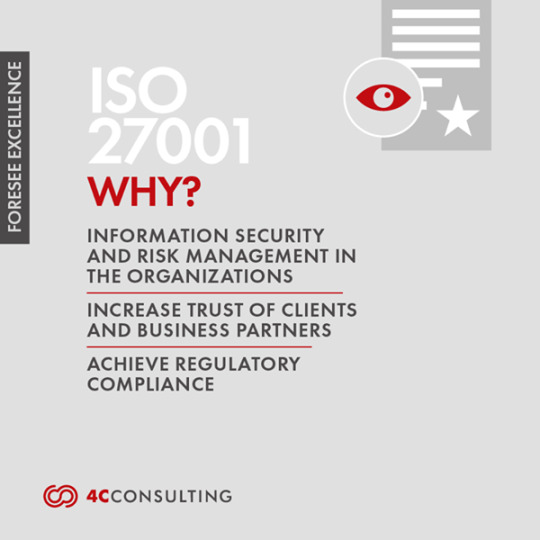
Whether you're a startup, SME, or established IT company, an ITES certificate can unlock multiple benefits:
✅ 1. Access to Government Incentives
The Indian government promotes ITES businesses through schemes like STPI (Software Technology Parks of India) and SEZ (Special Economic Zones). An ITES certificate is required to apply for these programs, which offer tax holidays, infrastructure benefits, and regulatory ease.
✅ 2. Global Business Credibility
When dealing with international clients, documentation plays a big role in building trust. Having an ITES certificate demonstrates your company’s legitimacy and industry classification.
✅ 3. Eligibility for Export Registration
Planning to export your services? ITES certification streamlines your IEC (Import Export Code) registration and helps categorize your company correctly with Export Promotion Councils.
✅ 4. Tender & RFP Compliance
Large-scale government and enterprise tenders often mandate ITES certification. Having it gives you a competitive edge when bidding for national and global contracts.
✅ 5. Smoother Taxation & Regulatory Compliance
The certificate helps with classification under SAC (Service Accounting Codes) for GST. This makes taxation and refund claims easier and more accurate.
🔹 Who Needs an ITES Certificate?
You should consider applying for an ITES certificate if:
You run a service-based business relying on IT infrastructure
You provide services to clients remotely or digitally
You aim to export your services
You’re planning to register under STPI or SEZ
You’re participating in government tenders or RFPs
Even freelancers or small agencies can apply, provided they have proper documents like GST registration, client agreements, and proof of service delivery.
🔹 Eligibility Criteria for ITES Certification
To be eligible for an ITES certificate, your business typically must:
Be legally registered (as Pvt. Ltd., LLP, OPC, or Partnership)
Offer IT-enabled services
Have relevant supporting documents like service agreements or invoices
Operate using IT infrastructure for service delivery
🔹 Step-by-Step Process to Get an ITES Certificate
Applying for an ITES certificate involves a few key steps. Here’s a breakdown:
Step 1: Organize Your Documents
Prepare the following:
PAN and GST certificates of the company
Incorporation certificate or LLP agreement
MoA (if applicable)
Business website and email domain
List of services offered
2–3 sample invoices or client contracts
Step 2: Choose the Right Certifying Body
Depending on your business needs, apply through:
STPI for export-focused firms
SEZ Authority if operating in a special zone
Export Promotion Councils (EPCs)
Or, for general classification, submit to relevant state IT departments
Step 3: Submit the Application
Most authorities have online portals. Upload documents, fill out the form, and pay any applicable fee.
Step 4: Verification
The certifying body may:
Review your application and documents
Conduct a physical or virtual verification
Request additional details, if necessary
Step 5: Receive Your Certificate
Once approved, the ITES certificate is issued — usually within 1 to 3 weeks.
🔹 Documents Required for ITES Certification
Here’s a general list:
Company PAN Card
GST Registration
Certificate of Incorporation / LLP Agreement
Director/Partner KYC (Aadhar, PAN)
Business website URL (optional but helpful)
List of ITES services provided
Client invoices, proposals, or service agreements
🔹 Post-Certification Compliance: What You Need to Maintain
Once you have the certificate, ensure you:
Keep records updated (new services, clients, etc.)
Renew the certificate if it has an expiry (based on issuing body)
Submit reports or documents if required annually
Maintain consistency in classification for taxation and export filings
🔹 Use Cases: Who Benefits from ITES Certification?
Sectors that benefit the most include:
BPO/KPO companies
SaaS startups
IT consulting firms
FinTech and EdTech startups
Data analytics service providers
UI/UX & software development agencies
Digital marketing agencies
🔹 Final Thoughts: Make Your Services Export-Ready
An ITES certificate is more than a compliance document — it’s a growth enabler. From gaining access to government schemes to boosting your reputation in global markets, it’s a powerful credential for any service-based business in India.
If you're planning to scale your services, apply for government incentives, or attract global clients — now’s the time to get ITES certified.
#ITESCertificate#ITESIndia#ServiceBasedBusiness#ITEnabledServices#ExportServices#SEZIndia#DigitalServices#Consulting
0 notes
Text
The Role of Technology in Proposal Bidding

As industries move towards digitization, proposal bidding is also experiencing a technological transformation. Digital tools and platforms have streamlined the process, making it more efficient, data-driven, and accessible to a wider range of participants.
One of the most significant benefits of technology in proposal bidding is the automation of repetitive tasks. Proposal management software can assist in creating templates, tracking progress, and ensuring compliance with RFP requirements. These tools enable teams to focus on strategic aspects, such as proposal crafting and client relationship-building, rather than administrative paperwork.
Data analytics enhance the bidding process by providing vital insights into pricing trends, competitor strategies, and market dynamics. By leveraging intelligence gathered from past bids, companies can fine-tune their proposals to align with client expectations and set competitive offers 東京都 プロポーザル.
Moreover, cloud-based platforms promote collaboration across distributed teams. With stakeholders often spread across different locations, these tools enable real-time communication and shared access to documents, fostering an environment that encourages innovation and cohesive team output.
Security is another critical consideration in digital bidding. Technologies such as encrypted communications and secure document storage ensure that sensitive information remains confidential. As data breaches become more sophisticated, bidders must invest in robust security measures to protect their interests and maintain client trust.
Finally, e-bidding platforms now facilitate online submission, evaluation, and award processes, reducing time delays and minimizing the environmental impact of paper-based submissions. This evolution encourages a greener, more sustainable approach to bidding.
0 notes
Text
The Key Steps in Vendor Selection: How to Pick the Perfect Partner for Success
Choosing the right vendor can have a significant impact on your business’s success. With an abundance of vendors providing similar services, selecting the right one can feel overwhelming. However, with a solid market intelligence strategy in place, you can streamline the process and make informed decisions that drive your business forward. This blog provides a comprehensive guide to the vendor selection process, helping you assess the key factors to consider when choosing a partner for your business.
Step 1: Understand the Vendor Selection Process
The first step in the vendor selection process is to understand the project’s requirements and define the selection criteria. These criteria should be based on your business’s needs and goals. Whether you're looking for an IT service provider, a procurement partner, or a software vendor, understanding what you need is essential for making an informed decision. A market intelligence strategy can help you gather data on potential vendors’ strengths and weaknesses, allowing you to select the best match for your business.
Step 2: Define Clear Requirements
Before you start searching for potential vendors, it’s crucial to define your project’s scope, budget, and timeline. This involves evaluating the project’s goals, understanding the resources needed, and considering any regulatory or compliance requirements. Once you have a clear grasp of what you need, you can move forward with the selection process.
For example, if you need a technology partner, you might need to define whether you require cloud-based solutions, cybersecurity services, or software development. The more specific you are about the project’s requirements, the better you will be able to evaluate vendors based on how well they align with your objectives.
Step 3: Research Potential Vendors
Once you have a clear understanding of your business’s needs, it's time to identify potential vendors. Use various sources, such as industry reports, online research, and recommendations from trusted colleagues, to build a list of suitable candidates. Leverage market intelligence tools to gather insights into vendors' market reputation, experience, and past performance.
Key factors to consider when researching vendors include:
Industry experience: Vendors who have experience in your specific industry are more likely to understand your needs and challenges.
Customer service standards: A reliable vendor should have excellent customer service to address any issues or concerns that may arise during the project.
Financial stability: Evaluate the vendor’s financial health to ensure they can meet your requirements without the risk of instability.
Reputation and track record: Look for vendors with a proven history of delivering quality services on time.
Step 4: Create Vendor Selection Criteria
After identifying potential vendors, it’s time to create a set of criteria that will guide your decision-making. These criteria should cover various aspects such as:
Experience and expertise: Does the vendor have a proven track record in delivering similar projects?
Quality of service: Is the vendor known for providing high-quality services consistently?
Pricing structure: Is the vendor’s pricing competitive, and does it offer value for money?
Delivery timelines: Does the vendor meet deadlines, or do they have a history of delays?
Developing clear and specific criteria will help you compare vendors more objectively. Additionally, creating a Request for Proposal (RFP) that outlines these criteria will allow vendors to submit detailed responses that align with your expectations.
Step 5: Evaluate Vendor Proposals
Once you have received vendor proposals, the next step is to evaluate them based on your selection criteria. This evaluation process should include:
Proposal analysis: Compare the proposals to determine which vendors meet the most criteria and offer the best value for money.
Interviews and meetings: Conduct interviews or meetings with potential vendors to gain further insights into their capabilities and approach.
Reference checks: Contact past clients to verify the vendor's performance, reliability, and ability to meet deadlines.
Use your market intelligence strategy to benchmark proposals against industry standards, which will help you assess whether the vendor is competitive and capable of meeting your needs.
Step 6: Negotiate Terms and Finalize the Deal
Once you've identified the best vendor for your project, the next step is to negotiate the terms of the contract. This is where careful planning is crucial. The contract should clearly outline:
Scope of services: Define the exact services the vendor will provide.
Pricing: Ensure that pricing is transparent and competitive.
Delivery timelines: Set clear deadlines for project milestones.
Payment terms: Agree on how and when payments will be made.
Service level agreements (SLAs): Define performance standards and penalties for non-compliance.
A strong negotiation process, backed by insights from your market intelligence strategy, will help ensure that you secure favorable terms and establish a mutually beneficial partnership.
Step 7: Monitor Vendor Performance
Once the vendor is selected and the contract is signed, it’s essential to monitor their performance throughout the project. Establishing key performance indicators (KPIs) will allow you to track progress and ensure that the vendor is meeting the agreed-upon objectives. Regular check-ins, performance reviews, and feedback sessions will help address any issues that arise and keep the project on track.
Key aspects to monitor include:
Timely delivery: Ensure that the vendor is meeting deadlines and providing deliverables as agreed.
Quality of work: Regularly assess the quality of services or products being delivered.
Customer satisfaction: Monitor how well the vendor addresses any issues or concerns raised by your team.
Step 8: Evaluate and Review Vendor Relationships
After the project is completed, it’s important to evaluate the overall relationship with the vendor. This assessment should cover factors such as:
Vendor performance: Did the vendor meet your expectations in terms of quality, delivery, and service?
Communication and collaboration: How effective was the communication between your team and the vendor throughout the project?
Long-term partnership potential: Is the vendor a good fit for future projects, or would you consider working with them again?
By reviewing the vendor relationship, you can gain insights into what worked well and identify areas for improvement, helping you optimize future vendor selection processes.
Strategic Advantages of a Thorough Vendor Selection Process
By following a comprehensive vendor selection process, businesses can achieve several strategic advantages, including:
Cost Efficiency: A thorough selection process helps businesses avoid hidden costs and ensure that they are getting the best value for money.
Quality Assurance: A robust evaluation ensures that vendors meet the required standards, improving the reliability of goods and services.
Risk Mitigation: By thoroughly vetting vendors, businesses can minimize the risk of delays, quality issues, and potential business disruptions.
Time Optimization: A streamlined vendor selection process reduces the time spent on finding and evaluating vendors, allowing businesses to focus on other priorities.
Regulatory Compliance: A structured approach ensures that vendors adhere to necessary legal and regulatory requirements, minimizing the risk of non-compliance.
By utilizing a market intelligence strategy, businesses can ensure that they are making the right vendor selection, setting the stage for long-term success.
Conclusion
In, the vendor selection process plays a crucial role in driving business growth and ensuring successful project execution. By following a systematic approach—one that incorporates market intelligence strategy—you can make well-informed decisions that benefit your organization in the long run. Whether you're selecting a technology partner or a service provider, a thoughtful, data-driven process will ensure that you choose the right vendor to help you achieve your goals.
For more information please contact
0 notes
Text
E-tendering Software: Streamlining Procurement and Bidding Processes
Tendering is a critical process in modern procurement, enabling businesses to select the best suppliers through competitive bidding. Traditionally, the tendering process has been time-consuming, involving paper-based documents and complex communication channels that often led to inefficiencies. However, with the advancement of technology, e-tendering software has revolutionized this process by automating and streamlining bidding activities.
E-tendering platforms offer significant improvements in speed, accuracy, and transparency. This article delves into the top 5 e-tendering software solutions on the market, designed to help organizations simplify and enhance their procurement processes.
What is E-Tendering?
F-tendering refers to the process of conducting tendering and bidding activities using online platforms and digital tools. It allows suppliers to submit bids electronically, and enables businesses to evaluate those bids in a secure, transparent, and efficient manner.
Unlike traditional methods, e-tendering eliminates paper documents, reduces administrative work, and enhances communication between stakeholders. By automating tasks such as bid creation, submission, and evaluation, e-tendering platforms help organizations reduce human error and ensure a faster, more effective procurement process.
Key Features of E-Tendering Software
When selecting e-tendering management software, its essential to evaluate features that align with your organization’s needs. Here are some of the critical capabilities to look for:
1. Tender Creation and Distribution
A reliable e-tendering platform should support customizable templates and automated workflows. This makes it easier to create and distribute tenders quickly and securely, ensuring that all relevant stakeholders receive the necessary information promptly.
2. Bid Management
Look for software that facilitates bid reception, organization, and evaluation. The software should streamline the management of incoming bids, reducing manual effort and enhancing the transparency of the selection process.
3. Collaboration and Communication
Effective communication between buyers, suppliers, and internal stakeholders is crucial. E-tendering software should offer collaboration tools like messaging systems, document sharing, and real-time updates to facilitate interaction throughout the bidding process.
4. Reporting and Analytics
A robust e-tendering system should include reporting tools that enable users to track bidding performance. These insights can help inform procurement decisions and identify areas for process improvement.
5. Compliance and Audit Trail
To meet regulatory requirements, the software must support compliance features and maintain a clear audit trail. This ensures that all bidding activities are well-documented and transparent, making it easier to verify and audit processes.
6. Integration Capabilities
E-tendering solutions should integrate seamlessly with other business systems, such as ERP, CRM, and project management tools. This helps streamline workflows and enhances overall process efficiency.
These features ensure that your e-tendering software boosts transparency, collaboration, and compliance while improving procurement outcomes.
Top 5 E-Tendering Software Solutions
Here are the top 5 e-tendering software solutions that can help streamline your bidding process and optimize procurement:
1. 8Manage eTender
8Manage eTender is an advanced e-tendering software that automates the entire RFx process, including the creation and management of tenders, RFIs, RFQs, RFPs, RFTs, and competitive bids. This platform ensures a structured, transparent, and efficient bidding process.
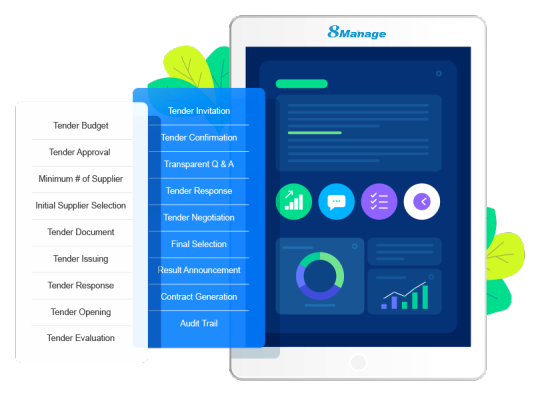
Supplier Management: Access detailed supplier information, qualifications, and performance records via a centralized database, enhancing supplier engagement and collaboration.
Bid Evaluation and Scoring: Customize evaluation criteria, assign weights, and conduct objective bid assessments for fair decision-making.
Automation: Automate workflows to streamline bid approvals and reduce manual interventions, improving efficiency.
Reporting and Analytics: monitor the status of ongoing tenders, evaluate the performance of suppliers, and track key metrics such as bid success rates, contract compliance, and procurement cycle times.
Integration: Integrate with other business systems like ERP, CRM, and project management tools for a seamless workflow.
With its user-friendly interface, powerful automation features, and extensive supplier management capabilities, 8Manage eTender stands out as one of the best e-tendering solutions for organizations seeking to optimize their procurement processes.
2. SAP Sourcing
Part of the SAP procurement suite, SAP Sourcing offers a comprehensive solution for bidding and tendering, with powerful automation tools and integration capabilities. Ideal for large organizations, SAP Sourcing simplifies complex procurement processes.
Key Features:
Customizable Bidding Process: With the ability to define templates, create specific workflows, and set evaluation criteria, users can adjust the system to fit the nuances of their procurement policies.
Supplier Collaboration Portal: SAP Sourcing provides a dedicated portal for suppliers, which streamlines communication and document submission.
Automated Bid Evaluation: Reduce manual work with automatic bid scoring based on predefined criteria, ensuring that assessments are fair and objective.
Reverse Auctions and Negotiation: Use reverse auctions to foster competition and secure the best pricing. The software also facilitates negotiations, making it easier for procurement teams to reach mutually beneficial agreements.
3. Bonfire
Bonfire is a highly efficient strategic procurement platform designed to simplify the bidding process through integrated management tools. It supports both private and public sector procurement, making it a versatile solution for various industries.
Key Features:
Bid Creation and Document Management: Use custom templates to create accurate and consistent bidding documents, while also managing versions and collaborating in real-time.
Supplier Communication: Facilitate seamless communication with suppliers through the platform’s messaging system and secure document sharing capabilities.
Evaluation and Scoring Automation: Automatically evaluate bids based on customizable criteria, ensuring fairness and reducing manual labor.
Real-Time Collaboration: Enable real-time collaboration between stakeholders, improving transparency and decision-making.
4. Jaggaer
Jaggaer is a global leader in procurement technology, providing a comprehensive e-tendering solution that integrates seamlessly with other procurement tools. This platform is known for its intelligent procurement features and advanced automation capabilities.
Key Features:
Supplier Qualification and Management: Jaggaer helps organizations maintain a centralized database of suppliers, track their qualifications, and evaluate their performance. This ensures that only qualified suppliers are invited to bid.
Smart Procurement Automation: Using artificial intelligence (AI) and machine learning, Jaggaer automates tasks such as bid creation, distribution, and evaluation, reducing manual work and improving accuracy.
Real-Time Auctions and Negotiations: The platform supports real-time auctions and enables negotiations between buyers and suppliers to achieve better pricing and terms.
Comprehensive Reporting and Analytics: Jaggaer provides powerful reporting tools to track procurement performance, supplier activity, and bid outcomes. These insights help organizations improve their procurement strategies and make data-driven decisions.
5. Procore
While Procore is primarily designed for the construction industry, its comprehensive bidding and tendering management features make it an excellent choice for companies in construction and related sectors. Procore helps construction companies optimize their procurement workflows, manage suppliers, and streamline bidding.
Key Features:
Bid Distribution: Procore simplifies the distribution of bid packages to potential bidders, ensuring that all necessary project documents are shared efficiently.
Prequalification: Procore allows construction companies to prequalify bidders based on experience, financial stability, and past performance, ensuring that only the most qualified suppliers participate in the bidding process.
Document Management: Procore’s powerful document management features help streamline the storage and sharing of bid-related documents, with version control and real-time updates ensuring that all stakeholders are working with the latest information.
Bid Evaluation: Procore enables easy comparison of bids based on factors such as price, qualifications, and timeline, helping procurement teams make more informed decisions.
Which E-Tendering Software is Right for Your Business?
Choosing the right e-tendering solution depends on various factors. Here are some considerations to help you make the best decision for your business:
Industry Expertise and Coverage: Ensure that the software meets the specific needs of your industry. Different sectors, such as construction, manufacturing, or IT, may require specialized features.
User Experience: Select a platform that is intuitive and user-friendly. The software should simplify the bidding process rather than complicating it.
Technical Support: Ensure that the software provider offers reliable customer support and training resources to help you navigate the platform effectively.
Cost-Benefit Analysis: Evaluate the software’s return on investment (ROI). Consider both short-term costs and long-term efficiency gains.
By carefully assessing these factors, you can select the most suitable e-tendering software to streamline your procurement process and improve your chances of success in competitive bidding.
8Manage eTender stands out as a comprehensive and highly customizable solution for organizations looking to streamline their bidding processes. With advanced automation, supplier management tools, and seamless integration capabilities, it is an excellent choice for companies seeking efficiency, transparency, and compliance in their procurement processes.
0 notes
Text
Automating Proposals and Contracts: How Document Generation Tools Help Sales Teams
Most sales teams understand the importance of timely and accurate proposals and contracts in closing deals and building strong relationships with clients. However, the process of creating these documents can be time-consuming and prone to errors, taking away from the time sales teams could be spending on high-value activities like building relationships and closing deals.
This is where document generation tools come in – automating the proposal and contract creation process to save sales teams time, reduce errors, and improve the overall customer experience. By leveraging these tools, sales teams can focus on what they do best: selling.
Document generation tools use data from various sources, such as customer relationship management (CRM) systems, to populate templates with relevant information. This eliminates the need for manual data entry, reducing the risk of errors and inconsistencies. With the ability to generate documents in a matter of minutes, sales teams can respond quickly to RFPs and quickly turn around proposals, giving them a competitive edge.
One of the key benefits of Online Document Generator tools is their ability to ensure consistency and compliance. By using pre-approved templates and clauses, sales teams can ensure that all proposals and contracts meet the company's brand and legal standards. This not only reduces the risk of non-compliance but also helps to maintain a professional image. In addition to saving time and reducing errors, document generation tools also provide sales teams with valuable insights and analytics. By tracking document interactions, sales teams can gain a better understanding of how clients are engaging with their proposals and contracts, allowing them to tailor their approach and improve their chances of closing deals.
Another significant advantage of document generation tool is their ability to facilitate collaboration and approval processes. With the ability to share documents electronically and track changes, sales teams can work more efficiently with colleagues and stakeholders to finalize proposals and contracts. This streamlines the approval process, reducing the time it takes to get documents signed and sealed.
When identifying a Digital Document Management Software, sales teams should consider several factors, including ease of use, integration with existing systems, and customization options. They should also look for tools that offer advanced features, such as electronic signature capabilities and document analytics.
In closing, automating proposals and contracts with document generation tools can have a significant impact on sales teams' productivity and performance. By reducing errors, improving consistency, and providing valuable insights, these tools can help sales teams close more deals and build stronger relationships with clients. As the sales landscape continues to evolve, it is vital for sales teams to leverage technology to stay ahead of the competition.
0 notes
Text
How to Identify the Best Software Solutions Company in India for Your Business Needs
In today's rapidly evolving digital landscape, businesses across India are increasingly turning to software solutions to streamline operations, enhance efficiency, and drive growth. With a plethora of software solutions companies in India, selecting the right partner can be a daunting task. This blog post will guide you through the key factors to consider when identifying the best software solutions company to meet your specific business needs.

Understanding Your Business Requirements
Before embarking on your search, it's crucial to have a clear understanding of your business requirements. Consider the following questions:
What specific problems or challenges do you want to address with software solutions?
What are your long-term goals and objectives?
What are your budget constraints?
What level of technical expertise do you have in-house?
By answering these questions, you can create a detailed profile of your ideal software solution.
Key Factors to Consider When Choosing a Software Solutions Company
Domain Expertise:
Industry-Specific Knowledge: Look for a company with a strong understanding of your industry. For instance, if you're in the insurance sector, a software solutions company in In specializing in Insurance Software Solutions would be the ideal choice.
Proven Track Record: Consider the company's experience in delivering successful projects for clients similar to you.
Technical Proficiency:
Skilled Team: Ensure the company has a team of highly skilled developers, engineers, and project managers.
Cutting-Edge Technologies: The company should be up-to-date with the latest technologies and trends.
Customization Capabilities: The ability to tailor software solutions to your specific needs is essential.
Customer Support and Service:
Responsive Support: Timely and effective customer support is crucial for a smooth implementation and ongoing operations.
Proactive Maintenance: The company should offer regular updates and maintenance to keep your software solutions running optimally.
Security and Data Privacy:
Robust Security Measures: Data security should be a top priority for any software solutions company.
Compliance with Regulations: Ensure the company adheres to relevant data protection regulations.
Scalability and Flexibility:
Future-Proof Solutions: The software solutions should be scalable to accommodate your growing business needs.
Adaptability to Change: The company should be able to adapt to evolving business requirements.
Cost-Effective Solutions:
Value for Money: Evaluate the overall cost of ownership, including licensing fees, implementation costs, and ongoing maintenance expenses.
Transparent Pricing: The company should provide clear and transparent pricing models.
How to Evaluate Potential Software Solutions Companies
Once you've identified a few potential software solutions companies, consider the following evaluation methods:
Request for Proposals (RFPs): Clearly outline your requirements and ask potential companies to submit detailed proposals.
Client References: Reach out to previous clients to get firsthand feedback on the company's performance.
Online Reviews and Testimonials: Check online reviews and testimonials to gauge the company's reputation.
Trial Periods: If possible, request a trial period to test the software and evaluate the company's support.
By carefully considering these factors and conducting thorough research, you can identify the best software solutions company in India to partner with. A well-chosen partner can significantly impact your business's success by providing innovative, efficient, and reliable software solutions.
Consider Indicosmic Infotech Ltd. for your software solutions needs. Indicosmic, a trailblazing technology provider since 2016, pioneers innovation in the insurance and automotive sectors. Advanced roadside assistance solutions, providing seamless support to customers & revenue generation for you.
0 notes
Text
How Businesses Make Purchasing Decisions: Understanding B2B Buyer Behavior
In the complex world of business-to-business (B2B) transactions, understanding how companies make purchasing decisions is crucial for both buyers and sellers. B2B buyer behavior involves a series of steps and influences that differ significantly from consumer purchasing. This blog will delve into the intricacies of B2B buyer behavior, providing insights into the factors that shape purchasing decisions and offering strategies for businesses to effectively navigate this landscape.
The B2B Buying Process
Unlike business-to-consumer (B2C) transactions, B2B buying involves multiple stakeholders, longer decision-making processes, and more significant financial investments. The B2B buying process can be broken down into several stages:
1. Problem Recognition
The buying process begins when a company identifies a need or problem that requires a solution. This stage often involves discussions among various departments to pinpoint the exact issue. For instance, a manufacturing firm may realize that its production line is inefficient, prompting a search for new machinery or software.
2. Information Search
Once the problem is recognized, the next step is gathering information. Companies will conduct extensive research to understand available solutions. This may involve:
Internal Sources: Consulting with internal teams or reviewing past experiences.
External Sources: Seeking information from industry reports, online reviews, and recommendations from peers or industry experts.
3. Evaluation of Alternatives
After gathering information, companies will evaluate different solutions. This evaluation involves comparing various products or services based on criteria such as cost, quality, and vendor reputation. This stage is often marked by:
Request for Proposals (RFPs): Companies may issue RFPs to solicit bids from potential vendors.
Product Demos and Trials: Testing products to assess their suitability for the company’s needs.
4. Purchase Decision
The decision to purchase is made after thorough evaluation. This stage often includes negotiations on price, terms, and contract details. The final decision may involve:
Approval from Senior Management: Especially for high-value purchases, senior executives may need to approve the final decision.
Contract Finalization: Ensuring all terms are clearly defined and agreed upon.
5. Post-Purchase Evaluation
After the purchase, companies will assess the effectiveness of the solution. This evaluation helps determine if the product or service meets expectations and provides the desired results. Post-purchase evaluation can lead to:
Repeat Purchases: If satisfied, companies may continue to buy from the same vendor.
Feedback and Reviews: Companies may provide feedback or reviews based on their experience.
Key Factors Influencing B2B Buyer Behavior
Several factors influence how businesses make purchasing decisions. Understanding these factors can help vendors tailor their strategies to meet buyer needs effectively.
1. Organizational Structure
The structure of the buying organization affects the purchasing process. Large organizations may have dedicated procurement teams, while smaller companies might involve fewer people in the decision-making process. Understanding the organizational structure helps vendors identify the right stakeholders to engage with.
2. Budget Constraints
Budget constraints play a significant role in B2B purchasing decisions. Companies must balance cost with value, ensuring that the solution fits within their budget while meeting their needs. Vendors need to offer solutions that provide a clear return on investment (ROI) to address budget concerns.
3. Risk Management
B2B buyers are often risk-averse and seek solutions that minimize risk. This can involve evaluating the reliability of the vendor, the durability of the product, and the potential for any negative impact on the business. Demonstrating reliability and offering warranties or guarantees can help alleviate concerns.
4. Decision-Making Process
The decision-making process in B2B buying is usually collaborative and involves multiple stakeholders. Understanding the roles and priorities of each decision-maker can help vendors tailor their pitch to address specific concerns and requirements.
5. Market Trends
Keeping abreast of market trends and industry developments can influence B2B buying behavior. Companies may seek solutions that align with current trends or emerging technologies to stay competitive. Vendors should stay informed about industry trends to offer relevant solutions.
6. Vendor Reputation
A vendor’s reputation plays a crucial role in B2B buying decisions. Buyers often prefer vendors with a proven track record of reliability and customer satisfaction. Building a strong reputation through excellent service, customer support, and successful case studies can enhance credibility.
Strategies for Vendors to Influence B2B Buyer Behavior
To effectively influence B2B buyer behavior, vendors should consider the following strategies:
1. Tailored Solutions
Offering customized solutions that address specific business needs can set vendors apart. Tailored solutions demonstrate an understanding of the buyer’s unique challenges and provide a competitive edge.
2. Educational Content
Providing valuable educational content, such as white papers, case studies, and webinars, can position vendors as industry experts. Educational content helps buyers make informed decisions and builds trust in the vendor’s expertise.
3. Strong Online Presence
A robust online presence, including a professional website and active social media profiles, can enhance visibility and attract potential buyers. Ensuring that online content is informative and engaging can help capture the attention of decision-makers.
4. Effective Networking
Building relationships through networking events, industry conferences, and trade shows can facilitate connections with potential buyers. Networking provides opportunities to engage with key stakeholders and showcase products or services.
5. Customer Support
Offering exceptional customer support throughout the buying process can make a significant impact. Providing timely responses to inquiries, addressing concerns, and offering post-purchase support can enhance the overall buyer experience.
6. Feedback and Improvement
Actively seeking feedback from customers and using it to improve products or services demonstrates a commitment to customer satisfaction. Continuous improvement based on feedback can help build long-term relationships with buyers.
The Future of B2B Buyer Behavior
As technology and market dynamics evolve, B2B buyer behavior will continue to change. Emerging trends such as digital transformation, artificial intelligence, and data analytics are reshaping how businesses make purchasing decisions. Staying ahead of these trends and adapting strategies accordingly will be essential for vendors to remain competitive.
1. Digital Transformation
The increasing reliance on digital tools and platforms is transforming the B2B buying process. Companies are leveraging digital channels for research, evaluation, and purchasing. Vendors should invest in digital marketing and online tools to engage with buyers effectively.
2. Artificial Intelligence
Artificial intelligence (AI) is playing a growing role in B2B buying decisions. AI-powered tools can provide insights into buyer behavior, personalize marketing efforts, and automate certain aspects of the buying process. Embracing AI technology can enhance efficiency and effectiveness.
3. Data-Driven Decision Making
Data analytics is becoming crucial for understanding buyer behavior and making informed decisions. Analyzing data on customer interactions, preferences, and purchasing patterns can provide valuable insights for developing targeted strategies.
Conclusion
Understanding B2B buyer behavior is essential for businesses seeking to succeed in the competitive world of B2B transactions. By comprehending the stages of the buying process, key influencing factors, and effective strategies, vendors can better navigate the complexities of B2B buying and build strong relationships with their clients.
As the landscape continues to evolve, staying informed about trends and leveraging advanced technologies will be crucial for maintaining a competitive edge. By focusing on tailored solutions, educational content, and exceptional customer support, vendors can effectively influence B2B buyer behavior and achieve long-term success.
For more insights into B2B buyer behavior and effective strategies for navigating the B2B landscape, visit Philomath Research.
FAQs
1. What is B2B buyer behavior?
B2B (business-to-business) buyer behavior refers to the process and factors influencing how businesses make purchasing decisions when buying products or services from other businesses. This process typically involves multiple stakeholders, extensive research, and a focus on cost-effectiveness and value.
2. What are the key stages of the B2B buying process?
The B2B buying process includes several key stages:
Problem Recognition: Identifying a need or problem within the organization.
Information Search: Gathering information about potential solutions.
Evaluation of Alternatives: Comparing different products or services based on criteria such as cost, quality, and vendor reputation.
Purchase Decision: Making the final decision to buy and negotiating terms.
Post-Purchase Evaluation: Assessing the effectiveness of the solution and its impact on the organization.
3. What factors influence B2B buyer behavior?
Key factors influencing B2B buyer behavior include:
Organizational Structure: The internal structure and decision-making process of the buying organization.
Budget Constraints: Financial limits and the need to balance cost with value.
Risk Management: The need to minimize risk and ensure reliability.
Decision-Making Process: The roles and priorities of different stakeholders involved in the buying decision.
Market Trends: Current trends and emerging technologies in the industry.
Vendor Reputation: The credibility and track record of the vendor.
4. How can vendors effectively influence B2B buyer behavior?
Vendors can influence B2B buyer behavior by:
Offering Tailored Solutions: Customizing products or services to meet specific business needs.
Providing Educational Content: Sharing valuable insights through white papers, case studies, and webinars.
Maintaining a Strong Online Presence: Ensuring a professional and engaging online profile.
Engaging in Effective Networking: Building relationships through industry events and conferences.
Delivering Excellent Customer Support: Offering timely responses and post-purchase assistance.
Seeking Feedback and Improvement: Using customer feedback to enhance products and services.
5. What role does digital transformation play in B2B buyer behavior?
Digital transformation is reshaping B2B buyer behavior by increasing reliance on digital tools and platforms for research, evaluation, and purchasing. Vendors should leverage digital marketing, online tools, and technology to engage with buyers effectively.
6. How is artificial intelligence (AI) impacting B2B buying decisions?
AI is impacting B2B buying decisions by providing insights into buyer behavior, personalizing marketing efforts, and automating aspects of the buying process. AI tools can enhance efficiency and help vendors better understand and meet buyer needs.
7. Why is data-driven decision-making important in B2B transactions?
Data-driven decision-making is important because it allows vendors to analyze customer interactions, preferences, and purchasing patterns. This analysis provides valuable insights for developing targeted strategies and improving the effectiveness of marketing and sales efforts.
8. How can businesses stay competitive in the evolving B2B landscape?
To stay competitive, businesses should focus on understanding B2B buyer behavior, adapting to emerging trends, and leveraging advanced technologies. This includes investing in digital transformation, using AI and data analytics, and maintaining strong customer relationships through tailored solutions and exceptional support.
9. Where can I find more information about B2B buyer behavior and effective strategies?
For more insights into B2B buyer behavior and strategies for navigating the B2B landscape, visit Philomath Research.
#b2b market research#b2b buying behavior#b2b market research services#market research companies#b2b research
0 notes
Text
Hire Development Agency Ahmedabad for Custom Software Development | Expert Guide
In today's fast-paced digital world, custom software development has become the backbone for businesses looking to automate processes, enhance customer experiences, and stay competitive. If you're considering hiring a development agency in Ahmedabad for custom software development, you're making a wise decision. Ahmedabad, a bustling IT hub, offers a range of talented developers and agencies specializing in creating tailored software solutions that align with your business goals.
This guide will provide you with everything you need to know about hiring a development agency for custom software development in Ahmedabad. From understanding the process to choosing the right partner like i-Quall, we’ll break down the steps, benefits, and considerations so you can make an informed decision.
Why Custom Software Development?
Custom software development is the process of creating unique, tailor-made solutions to address the specific needs of a business. Unlike off-the-shelf software, which offers generic features, custom software is built to align perfectly with the business's goals, workflows, and customer interactions.
Benefits of Custom Software Development:
Tailored Solutions: Custom software is designed specifically for your business needs.
Scalability: It can grow with your business, allowing for new features and capabilities to be added as needed.
Increased Efficiency: Streamline workflows and eliminate inefficiencies with a system designed just for you.
Competitive Advantage: Gain a market edge with a solution that differentiates you from competitors.
Improved Security: Custom solutions offer enhanced security measures compared to generic software.
How to Hire the Best Development Agency in Ahmedabad for Custom Software Development
When it comes to custom software development, choosing the right agency is critical. Ahmedabad boasts a number of reputable development agencies, each offering their own strengths. However, to ensure success, you need to consider several key factors when hiring a development agency in Ahmedabad:
Define Your Needs: Begin by identifying the problems you need the software to solve. Having a clear understanding of your objectives will help in selecting an agency that can meet your expectations.
Evaluate Expertise: Look for agencies with experience in the technologies you need. For example, if you require a robust backend with cloud capabilities, make sure the agency has a track record of successful projects using cloud infrastructure.
Review Portfolios: Ask the agency for a portfolio of their past work. This will give you insights into their design quality, user experience focus, and the industries they've worked in.
Check Client Reviews and Testimonials: Client feedback is essential. Look at reviews on platforms like Clutch and GoodFirms to gauge client satisfaction. You can also request references from the agency to directly ask about their experience.
Assess Communication: The success of a project often depends on how well the agency communicates. Ensure that they provide regular updates, and are responsive to questions and feedback.
Consider Costs: Custom software development can be costly, but it's essential to balance cost with quality. Opting for the cheapest agency may compromise the quality of the final product. A reliable agency will offer you a transparent, detailed quote with no hidden charges.
Step-by-Step Guide: Hiring a Development Agency in Ahmedabad
Research the Market Begin by conducting thorough research on the development agencies in Ahmedabad. Look for agencies that specialize in custom software development, and make sure they have a strong online presence.
Shortlist Potential Agencies Based on your research, create a list of 5-10 agencies. Evaluate their expertise, services, and past projects. Shortlist the ones that match your project requirements.
Request Proposals Send a request for proposal (RFP) to each shortlisted agency. In the RFP, outline your project’s goals, timeline, budget, and desired features. This will help the agencies provide a tailored proposal for your project.
Conduct Interviews Interview the agencies that responded to your RFP. During the interview, assess their communication skills, technical expertise, and their understanding of your business needs.
Assess Proposals Evaluate the proposals you receive. Look at factors like pricing, timelines, proposed technologies, and the agency’s approach to solving your business challenges.
Sign a Contract Once you've selected an agency, negotiate the contract terms. Ensure that the contract covers all aspects of the project, including deliverables, timelines, costs, intellectual property rights, and confidentiality.
Custom Software Development Technologies
Custom software development involves various technologies, frameworks, and tools. Here’s a quick rundown of some common technologies agencies in Ahmedabad use:
Frontend Technologies: HTML, CSS, JavaScript, Angular, React
Backend Technologies: Node.js, PHP, Python, Ruby on Rails, .NET
Databases: MySQL, PostgreSQL, MongoDB
Cloud Solutions: AWS, Microsoft Azure, Google Cloud Platform
Mobile App Development: iOS (Swift), Android (Kotlin), React Native, Flutter
Understanding the technologies involved will help you communicate better with the development agency and set realistic expectations for the project.
Example of a Successful Custom Software Development Project in Ahmedabad
Let's take an example of i-Quall, a leading software development agency based in Ahmedabad. Recently, i-Quall worked with a mid-sized retail company to create a custom inventory management system. The client needed software that could track stock across multiple stores, integrate with their eCommerce platform, and generate real-time analytics.
i-Quall successfully developed a scalable, secure, and intuitive solution that allowed the retailer to streamline operations, reduce manual data entry, and increase sales efficiency. The project was completed on time, within budget, and exceeded the client’s expectations.
If you’re looking for a reliable development agency in Ahmedabad, i-Quall should be on your radar. With years of experience in delivering high-quality custom software solutions, i-Quall has a proven track record of working with clients across different industries. Their commitment to innovation, customer-centric approach, and expertise in cutting-edge technologies make them a standout choice.
i-Quall’s team of developers are not just technically skilled, but also excellent communicators who ensure the project stays on track from start to finish. Whether you need a simple web application or a complex enterprise software solution, i-Quall has the tools, experience, and expertise to bring your vision to life.
Conclusion
Hiring a development agency in Ahmedabad for custom software development is a strategic decision that can elevate your business. With the right partner like i-Quall Infoweb, you can unlock the full potential of technology to meet your unique needs. By following the steps outlined in this guide and focusing on the right factors—expertise, communication, and quality—you can ensure the success of your custom software development project.
Make the move today to hire a trusted development partner and take your business to the next level!
URL : https://www.i-quall.com/ahmedabad/hire-development-agency-ahmedabad-for-custom-software-development/
0 notes
Text
How we built a Marketplace Platform MVP and integrated Generative AI
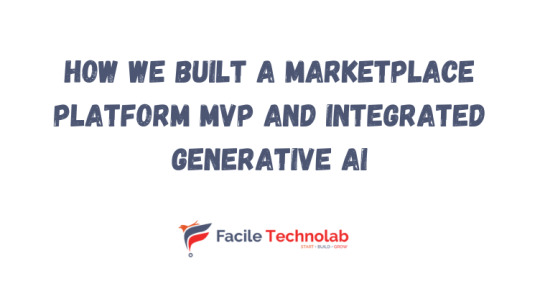
In this article, we will cover how our team helped launch an online marketplace platform mvp.
I'm going to share a story of our collaboration with one of our existing client. He has an amazing idea to innovate the way corporate event happens in the industry.
The client has good understanding of managing software projects. The client believed design thinking and building prototypes is key step to succeed. So, when our first engagement happened, the client had a figma prototype of 60% of the system ready.
The client's expectation was to get guidance on certain areas of the application. He also wanted to hire a team that converts the figma design into working system from start to finish. Since client had prior experience working with us, they contacted us for this new project.
The Marketplace MVP
The marketplace MVP was very easy to use. Being a corporate user, you are organizing corporate event. So, you will use the site to search for service providers. You will request for proposal. For each of the services you need, you can shortlist the quotation received.
Being a vendor, who serves corporate events, you can add your business and services. You can accept the RFP if it's relevant. Generate quote for the RFP received. Get confirmation of acceptance or rejection from the users.
The key features
The key features that we identified during discovery sprint are:
Responsive UI: Users should be able to use the system in the desktop, tablet and mobile devices.
Multilanguage: System should auto detect the user language from the browser. Ability for users to choose/switch their language.
Social Authentication: Ability for users to login with their Google and Facebook accounts.
Google Maps: Ability for users to see a maps view of the business or service listings
Marketing Plans: Monthly subscription for vendors to promote their listings.
Add Ons: One time add Ons for vendors to verify their business, paid profile setups, photo suites etc.
Listings: Ability for users to see the services based on city, category, and other filters.
Request for Proposal: Ability for users to request for proposals from the listing
Receive Quotes: Ability for users to receive quote from the interested vendors
Approve/Reject Quote: Ability for users to shortlist the quote.
ChatGPT Integration: ChatGPT API will help users to generate the language specific content. Here are some examples:
Ability for vendors to generate business and service listing description
Ability for users to generate request for proposal description
Ability for vendors to generate quote
Our approach
We started with a discovery sprint and shortlisted the in scope features. We also identified the gap in the Figma design prototypes and suggested improvements. At the end of the discovery sprint we had vision of in scope mvp features, timeline and budget.
Tech Stack: React.js, Next.js, Redux and Javascript in the front-end. ASP.NET Core, REST API, ASP.NET Web API, Entity Framework Core Code First, Azure SQL, Azure Storage used for back-end. We hosted both back-end and front-end applications in the Azure App Services.
The client engages throughout the project. Client received the dev site hosted on azure after first two sprints. Our team kept updating the dev site after every sprint. The client had flexibility to review and change things as we go.
The result
As we proceed towards the sprints, the client added some important features. Also, updated the UX for some of the modules to be more user friendly. Integrating stripe, google map, language and culture detection was also tricky. Finally, our team deliver all the MVP features with 100% client satisfaction.
Our team stood by the client for any support needed during the beta launch. We will be supporting client as they will go live with the full launch in Jan 2024.
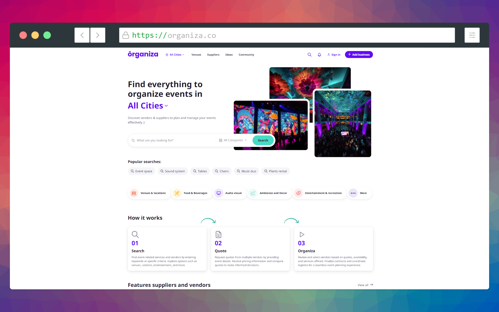
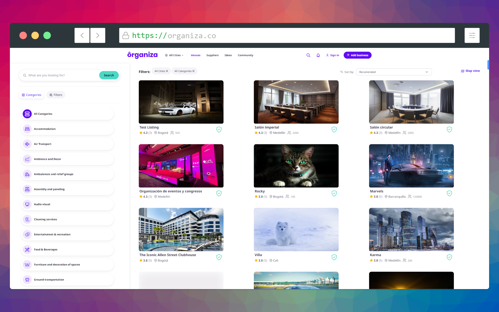
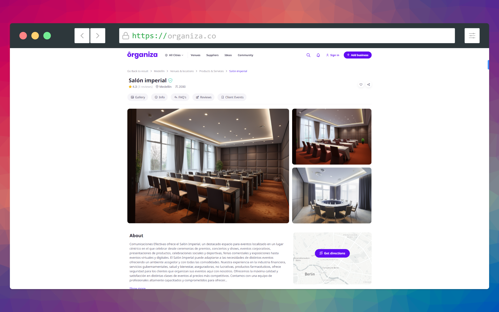
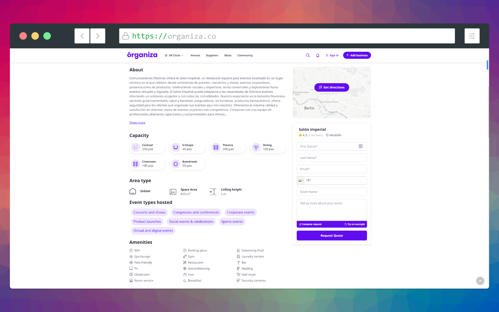
Conclusion
It was yet another successful project delivered! Our first product idea of building a marketplace platform mvp turned into reality! Subscribe to our newsletter to receive a notification as we publish related case study on our website.
Related case study: Online Marketplace Platform MVP for Event Management Industry

#saas development company#saas development services#saas development agency#saas application development service#saas application development solutions#saas app development services#saas development companies
0 notes
Text
The Benefits of Forward Auction Software for Procurement Success.

1. Increased competition
Forward auctions encourage competition among suppliers, driving them to offer competitive prices and better terms. With the help of auction software, companies can attract a wide range of suppliers, leading to increased competition and better value for the procuring organization.
2. Increased production efficiency
Forward auction software automates the procurement process, reducing the time and effort required for manual bid evaluations and negotiations. The automated nature of the software streamlines the process, allowing procurement professionals to focus on strategic tasks rather than administrative duties.
3. Real-Time Bidding
One of the key advantages of forward auction software is the ability to facilitate real-time bidding. Suppliers can submit their bids in real time allowing for the quick response and immediate feedback.
4. Transparent Process
Forward auction software provides transparency throughout the procurement process. All participants have access to real-time information about bids, allowing for a fair and objective evaluation. This transparency builds trust among suppliers and fosters a competitive environment.
5. Cost Reduction
Forward auctions promote cost reduction by encouraging suppliers to offer their best prices upfront. The competitive nature of the auction incentivizes suppliers to lower their prices, resulting in significant cost savings for the procuring organization.
6. Availability of a wider supply chain
This expands the pool of potential bidders, increasing the chances of finding the right supplier with the best value proposition. With a larger supplier base, organizations can benefit from greater flexibility and negotiate more favorable terms.
7. Improved market intelligence
Forward auction software provides valuable market intelligence to procurement professionals. This intelligence enables better decision-making and strengthens negotiation strategies.
8. Save time
The automated nature of forward auction software saves a significant amount of time for both buyers and suppliers. The software eliminates the need for manual paperwork, phone calls, and face-to-face meetings. This allows procurement professionals to expedite the procurement process and focus on other critical tasks.
9. Flexibility and flexibility
Forward auction software offers flexibility and customization options to meet the unique needs of different procurement processes. Organizations can tailor the software to align with their specific requirements, ensuring a seamless and efficient procurement experience.
10. Exchange of materials
Forward auction software is scalable, enabling Organizations to handle a large numbers of suppliers and bids. Whether the procurement needs are small or large, the software can handle the increased volume without compromising efficiency or performance.
Overall, Best Forward Auction software empowers organizations to achieve procurement success by leveraging advanced technology, enhancing competition, and streamlining the procurement process. With its numerous advantages, forward auction software is an indispensable tool for organizations aiming to optimize their procurement efforts.
For More information-
91-9069042875
1 note
·
View note
Text
Free markets Ariba

FreeMarkets, Ariba, and the Evolution of B2B Procurement
The acquisition of FreeMarkets by Ariba in 2004 was a significant moment in e-procurement history. It combined two innovative companies that helped shape how businesses buy and sell goods and services. Let’s delve into the story of FreeMarkets, Ariba, and why their merger was a big deal.
FreeMarkets: Pioneers of Online Auctions
Founded in 1995, FreeMarkets was one of the first companies to focus on business-to-business (B2B) online auctions. Their platform allowed buyers to create requests for proposals (RFPs) and invite suppliers to bid in real time. This dynamic marketplace promoted transparency and helped buyers secure lower prices for everything from raw materials to complex services.
FreeMarkets’ success highlighted the power of the internet in transforming procurement. Their model disrupted traditional sourcing methods, where relationships and long-term contracts often dictated prices.
Ariba: Spend Management Powerhouse
Ariba, established in 1996, had a broader focus within the procurement space. Their software solutions aimed to streamline the entire procure-to-pay (P2P) process. This included tools for:
Catalog management
Contract management
Invoice processing
Supplier relationship management
Ariba’s vision was to automate and optimize procurement operations, giving businesses better control over their spending and helping them build more robust supplier networks.
The Merger: A Strategic Fit
The combination of FreeMarkets and Ariba made excellent strategic sense:
Complementary Solutions: FreeMarkets’ auction-based sourcing complemented Ariba’s suite of spend management tools. Businesses could benefit from both dynamic price discovery and ongoing supplier collaboration.
Expanded Market Reach: The merger gave both companies a more extensive customer base and solidified their position as a leader in the rapidly growing e-procurement market.
Technological Innovation: Combining forces allowed for accelerated investment in R&D, leading to cutting-edge solutions for the evolving procurement landscape.
The Legacy of the Ariba-FreeMarkets Deal
The Ariba-FreeMarkets merger set a precedent for consolidation within the procurement software industry. It underscored the importance of strategic sourcing capabilities and end-to-end spend management tools.
Today, the technologies pioneered by FreeMarkets and Ariba are integral to modern procurement functions. Online auctions and reverse auctions are standard practices. Meanwhile, Ariba’s solutions continue evolving, forming part of SAP’s larger business software ecosystem.
Key Takeaways
The FreeMarkets/Ariba story demonstrates technology’s disruptive potential in traditional business processes like procurement.
E-procurement solutions deliver value by promoting price transparency, competition, and spend management efficiency.
Consolidation within the procurement software space continues as vendors strive to offer comprehensive, integrated platforms.
youtube
You can find more information about SAP ARIBA in this SAP ARIBA Link
Conclusion:
Unogeeks is the No.1 IT Training Institute for SAP Training. Anyone Disagree? Please drop in a comment
You can check out our other latest blogs on SAP ARIBA here – SAP ARIBA Blogs
You can check out our Best In Class SAP ARIBA Details here – SAP ARIBA Training
Follow & Connect with us:
———————————-
For Training inquiries:
Call/Whatsapp: +91 73960 33555
Mail us at: [email protected]
Our Website ➜ https://unogeeks.com
Follow us:
Instagram: https://www.instagram.com/unogeeks
Facebook: https://www.facebook.com/UnogeeksSoftwareTrainingInstitute
Twitter: https://twitter.com/unogeek
1 note
·
View note
Text
Ariba Sourcing Network

Unlocking the Power of Sourcing: A Guide to the Ariba Sourcing Network
In today’s rapidly evolving business landscape, procurement professionals are constantly pressured to streamline processes, maximize savings, and build resilient supply chains. The Ariba Sourcing Network, now part of SAP Business Network, is a powerful solution to address these challenges. This comprehensive platform empowers businesses to discover, connect, and collaborate with suppliers globally, revolutionizing sourcing and procurement.
What is the Ariba Sourcing Network?
At its core, the Ariba Sourcing Network is a vast digital marketplace where buyers and suppliers interact seamlessly. Think of it as a sophisticated online hub for all your sourcing needs. Key features include:
Global Supplier Network: Access a massive database of vetted suppliers across industries and locations.
Sourcing Events: Create and manage various sourcing events such as RFIs (Requests for Information), RFPs (Requests for Proposal), and RFQs (Requests for Quotation).
Contract Management: Negotiate, create, and manage contracts with suppliers, ensuring compliance and minimizing risk.
Automated Workflows: Reduce manual effort with automated workflows spanning sourcing, contract management, and supplier communication.
Analytics and Reporting: Gain real-time visibility into your procurement data to make informed sourcing decisions and track performance.
Key Benefits of the Ariba Sourcing Network
Cost Optimization: Discover new suppliers, negotiate favorable terms, and identify untapped savings opportunities.
Improved Efficiency: Streamline the entire sourcing process, from supplier discovery to contract execution, saving valuable time and resources.
Risk Mitigation: Vet suppliers before engagement, maintain up-to-date supplier information, and build a more resilient supply chain.
Enhanced Collaboration: Foster a more strategic supplier relationship through seamless communication and collaboration tools.
Data-Driven Decision-Making: Make informed choices backed by real-time data on supplier performance, market trends, and spending analysis.
Who Should Use the Ariba Sourcing Network?
The Ariba Sourcing Network is an invaluable tool for organizations of all sizes and across industries seeking to optimize their sourcing functions. It’s particularly well-suited for:
Businesses with complex sourcing needs: Manage multiple suppliers, diverse spend categories, and global supply chains effectively.
Companies focused on cost savings: Uncover new opportunities and optimize procurement costs.
Organizations looking to improve supplier relationships: Foster open communications and strategic partnerships with suppliers.
Getting Started with the Ariba Sourcing Network
If you’re ready to tap into the transformative power of the Ariba Sourcing Network, here are some initial steps:
Assess Your Needs: Analyze your current sourcing processes and identify areas for improvement.
Consult with SAP: Contact a representative to discuss tailored configuration and optimal integration with your existing systems.
The Future of Strategic Sourcing
The Ariba Sourcing Network isn’t just a software solution; it represents the future of strategic sourcing. By embracing this platform, organizations can unlock untapped potential, gain a competitive edge, and achieve true procurement excellence.
youtube
You can find more information about SAP ARIBA in this SAP ARIBA Link
Conclusion:
Unogeeks is the No.1 IT Training Institute for SAP Training. Anyone Disagree? Please drop in a comment
You can check out our other latest blogs on SAP ARIBA here – SAP ARIBA Blogs
You can check out our Best In Class SAP ARIBA Details here – SAP ARIBA Training
Follow & Connect with us:
———————————-
For Training inquiries:
Call/Whatsapp: +91 73960 33555
Mail us at: [email protected]
Our Website ➜ https://unogeeks.com
Follow us:
Instagram: https://www.instagram.com/unogeeks
Facebook: https://www.facebook.com/UnogeeksSoftwareTrainingInstitute
Twitter: https://twitter.com/unogeek
1 note
·
View note
Text
What is e-Tendering: Definition, Benefits & software
What is e-Tendering?
e-Tendering can help companies efficiently find the best suppliers for their procurement needs at the right price. Multiple suppliers respond electronically to procurement opportunities, competing to win sales or provide business services. An e-tendering system, based on internet technology, digitizes and integrates the entire tendering process, including bidding, evaluating, and contracting. It primarily consists of a network security system and an online business system. The system allows for the execution of online tendering, bidding, opening bids, evaluating bids, and monitoring activities, ultimately achieving efficient, professional, standardized, secure, and low-cost tender management.
e-Tendering (eTendering) involves using an online procurement (eProcurement) platform to automatically solicit bids and evaluate suppliers. It is a crucial part of the procurement process, aiding in the simplification of supply chain to procurement (S2P) operations and providing greater insights. Paperless e-tendering includes soliciting bids, submitting proposals based on formal procurement requirements, exchanging documents, and evaluating shortlisted potential suppliers and their bids. In the digital e-procurement process, the e-tendering stage occurs after the buyers requirement documents are prepared and approved, and some suppliers are pre-qualified or shortlisted.

When a buyer issues an Invitation to Tender (ITT) or Notice Inviting Tender (NIT) to potential suppliers responding to a procurement request, e-tendering operates through an internet-based online or mobile software platform, which may include a portal. E-tendering allows bidders to submit the required information by the deadline in response to a formal Request for Proposal (RFP), generate and exchange documents with electronic signatures and messaging, and evaluate procurement opportunities from bidding suppliers. Once a supplier is selected, the electronic bid becomes legally binding. Authorized employees can view relevant documents, but company policies should prohibit disclosing information before the contract is awarded. Companies can establish policies requiring e-tendering for procurements exceeding specific monetary thresholds or from particular sources.
Advantages of e-Tendering
The benefits of e-tendering include: - Providing an efficient and secure environment through online e-procurement systems. - Facilitating communication and interaction with built-in status updates and messaging functions. - Saving costs through more competitive bidding and tendering processes. - Improving quality through better supplier evaluation and selection. - Saving time with paperless e-tendering. - Reducing errors and post-contract disputes with a complete process.
Additionally, the paperless nature of e-tendering eliminates the costs associated with printing and distributing requests for proposals and contracts, further saving funds. It also avoids the need to send corrigenda for errors, as all corrections can be made online and communicated electronically. Lastly, companies can access digital data through e-procurement, AP automation, and ERP system integration, and make global bulk payments electronically.
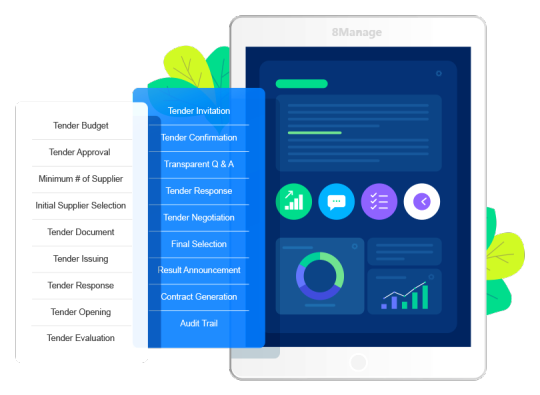
The 8Manage e-tendering system provides efficient, fair, and comprehensive monitoring for corporate bidding and tendering. Companies can pre-set tendering rules as needed, and the system strictly adheres to these rules throughout the process. Additionally, 8Manage offers robust security mechanisms to ensure the safety of all tendering processes and information. The system achieves security through mechanisms like security codes, one-time passwords, two-way communication encryption, role-based access control, and audit trails.
- User-customizable tender templates. - Tender expert management and tender approval management. - Supplier pre-selection, invitation, and participation management. - Tender document preparation and release management, tender consultation, bid opening, evaluation, negotiation, and award management. - Supplier announcements and electronic contract generation. - Comprehensive audit trails and tender analysis.
8Manage features transparent procurement, early warning supervision, traceable information, visualized data, and multi-party business collaboration. From tendering and bid evaluation to award management and supplier performance and contract completion, the system guides users through the entire tendering process. It helps companies improve tendering efficiency and prevent corruption. Throughout the corporate tendering process, information sharing among relevant departments is achieved, responsibilities are clearly defined, and procurement costs and transaction fees are effectively reduced, achieving the goal of cost reduction and efficiency improvement.
0 notes
Text
Automate Your RFP Process
TenderITnow is an RFP software that offers a bidding system for RFQ/RFP. It automates the process of sourcing and bidding on RFPs. With this software, you can create, share, manage and track your RFQs in one place.
The traditional way of handling RFQs is by using email to send them to suppliers and then waiting for a response. This way of doing things is time-consuming and inefficient. TenderITnow’s online bidding system will automate this process by making it easier for suppliers to submit their bids and for you to review them.
With TenderITnow(Online Software For RFP/RFQ), you can reduce the time and effort needed to get bids from suppliers by automating your entire bidding process. You can also increase your chances of winning the bid by getting more bidders on board with your RFQs.
TenderITnow is a comprehensive bidding software that lets you manage all your RFQ through email. You can save time by automating the process with us and let us do the work for you!
Let me know if you wish to see the demo.
Contact Number: +91 917 528 8052 | Email Id: [email protected]
#rfpsoftware#contisoft technologies#rfp#bidding software#online software for rfp#purchasehead#procurement
1 note
·
View note
Text

QUINN CLOTHING BRANDS
ALLENTOWN, PENNSYLVANIA
FOUNDED: 1981
AVAILABLE POSITION: CHIEF COUNSEL
Quinn Clothing Brands distributes Quinns products in the U.S. Founded in 1981, Quinn Clothing Brands is a leading global online retailer with operations in Bangladesh and Allentown, Pennsylvania, along with other key markets. Quinn Clothing Brands reaches consumers across more than 150 countries and regions around the world. We place a premium on choice, delivering more than 6,000 new fashion, beauty, and lifestyle products daily with more than 600,000 items available. Our mission is to help people express their individuality through the latest trends that are accessible and affordable.
This Counsel position directly reports to the US General Counsel. We are seeking a corporate generalist to handle a variety of commercial and employment matters.
RESPONSIBILITIES
Review, structure, draft and negotiate commercial agreements in a broad range of transactional disciplines, including marketing and service agreements, publishing agreements, production agreements, co founding agreements, NDAs, and license agreements.
[…] legal reports and […], and effectively present information to senior management.
[…] internal and external […], and perform legal research and […], to determine whether company […] comply with company policies, […] including with […]
[…] Department and outside counsel on a variety of labor and employment issues.
Manage and collaborate with top tier outside law firms.
service contracts, concession agreements, leases
group sales and catering agreements
master procurement agreements
data privacy and security, including data breach management
IT and software agreements
administrative licensing
development of standard forms, policies, and procedures
employee relations matters, including EEOC matters and union negotiations
employee benefits matters
guest issues
premises liability
crisis management
trademarks and service marks
tax advice and representation
REQUIREMENTS
Minimum of 6-8 years of corporate transactional law experience. In-house experience preferred.
Self-starter, entrepreneurial, “roll up your sleeves” attitude.
Exceptional legal drafting, research and analytical skills.
Pennsylvania bar admission and good standing with the state bar.
Experience with labor and employment counseling a major plus.
Experience with marketing and sweepstakes laws.

[GRAY DUCK] CHOCOLATE COMPANY
[ROCHESTER], MINNESOTA
[FOUNDED: ?]
AVAILABLE POSITION: DIRECTOR OF OPERATIONS
Rochester, Minnesota on the Zumbro River’s south fork
Gray Duck Chocolate Company [Headquarters in] Rochester, Minnesota
[…]

[GRAY DUCK] CHOCOLATE COMPANY
[ROCHESTER], MINNESOTA
[FOUNDED: ?]
AVAILABLE POSITION: DIRECTOR OF OPERATIONS
[…] company is trusted by […] customers, Gray Duck […] of more than […] revenues over $220 […] this trajectory […] momentum and is […] growth in […] acquisition. […] leadership […] before, having […] of over $3 […] vision, strong […] Gray […] assembled a […] culture with […].
[…] Chief Legal […] the Director of […]
[RESPONSIBILITIES]
[…]
[…]
Technology Strategy: Have end-to-end responsibility for the legal team’s technology strategy, from the RFP stage through implementation and maintenance, with the legal and compliance, finance and accounting, and IT teams as your key internal clients and partners. Identify and implement legal department tools to streamline new or existing practices, manage design, rollout, and training for new systems, and generally oversee the legal department’s technology strategy (including the selection, implementation, administration, and support of all technology resources related to matter and document management, content and knowledge management, e-billing management, contract management and related legal operations systems).
Outside Counsel Management: Develop and lead a process for positive and efficient outside counsel relationships. Identify and select firms (in partnership with attorneys) pricing negotiations, ongoing fee management, Diversity, Equity & Inclusion assessments, and […].
Communication & Professional Development: Coordinate the communication and professional development program for the legal department […]
Professional Management: […]
[…]
2 notes
·
View notes
Text
AVAIL THE SOFTWARE JOBS FOR OPT AND GET INFORMATICA TRAINING AND PLACEMENT IN USA.
As an aspirant for software, IT jobs, you need a consultant for your job choirs.
If you are getting confused with what job option you will go ahead as an OPT student, then it’s very much necessary that you are guided in the right direction. If you are looking for the best guide, then Wise I.T will give you the best advice to choose your career path wisely.
The Wise I.T comes with a wide range of research-based consulting. It is one of the best consultation platforms for USA based students. The services in Wise I.T are of many high standards with high quality. According to your knowledge, the Wise I.T will advise you for your best career job. The platform has come up with simple guides and has built upon the relationship with aspirants over the decades.
The Wise I.T got its specialization in various fields of IT sector. The advice and consultation the platforms gives deals with data warehousing, analytics and big data, master data management, vendor/ contract management. Along with these, the platform also guides you in PMI certified project management, RFP/RFI development. The Wise I.T has comfortably done the software job for opt students in the USA.
Along with various job opportunity to the OPT students, the platform also provides Informatica training and placement in the USA. It helps the aspirants to cope with online Informatica training and provide them with certification programme. The Wise I.T platform deals with all the main topics related to Informatica training. The platform guides the aspirants with various tools that are required for learning the Informatica course. The Informatica power centre has been widely used range for extraction, transformation and loading (ETL). This ETL helps in building the enterprise data warehouse.
It helps in extracting data from the sources and transforming it as per the business requirement.
All these technical set of courses will help the aspirants you get more strong knowledge about the Informatica training. This could lead them to get placement in various multinational software companies. The Wise I.T guide the aspirants in getting the Informatica training and provide them with the best placement in the USA.
Now, don’t sit idle and get yourself enrol with Wish I.T. Get your one-stop solutions for software jobs for OPT students in the USA and get the Informatica training and placement in the USA. Hurry up.
#it jobs for opt students#jobs for opt students in usa#software jobs for opt students in usa#software developer jobs in usa#best consultancies for opt students in usa
1 note
·
View note